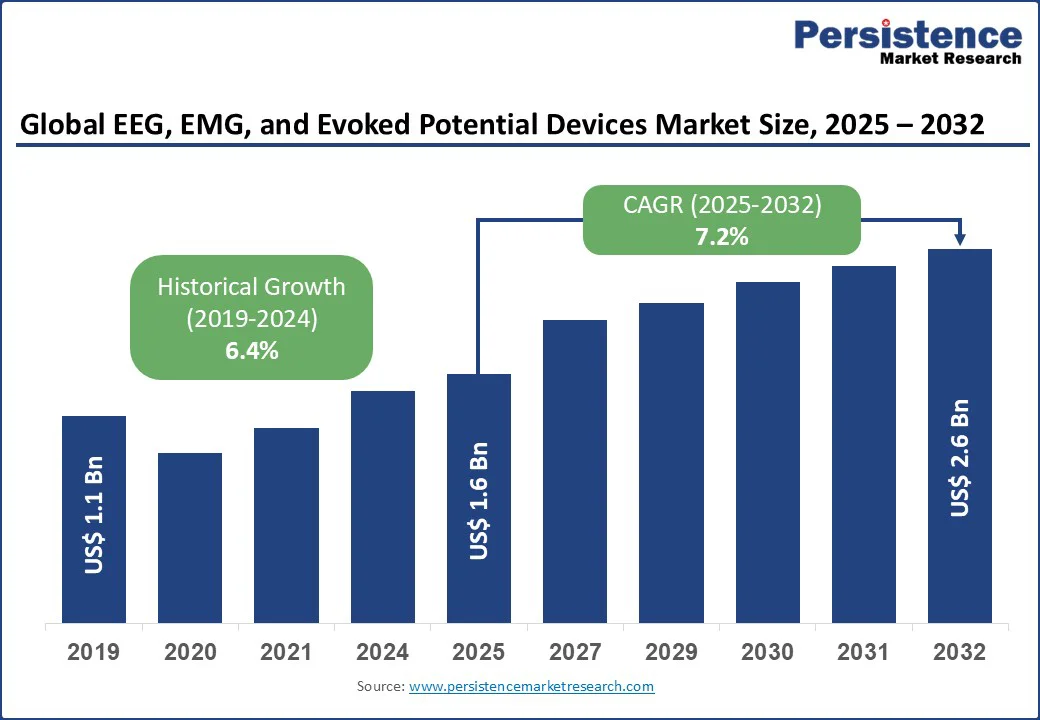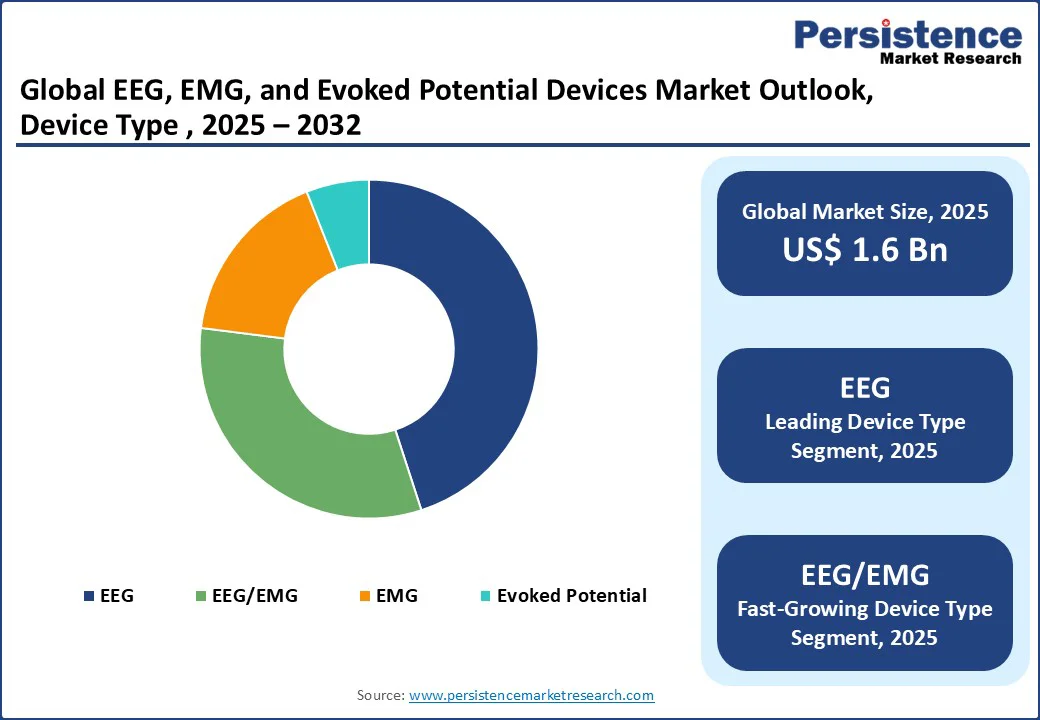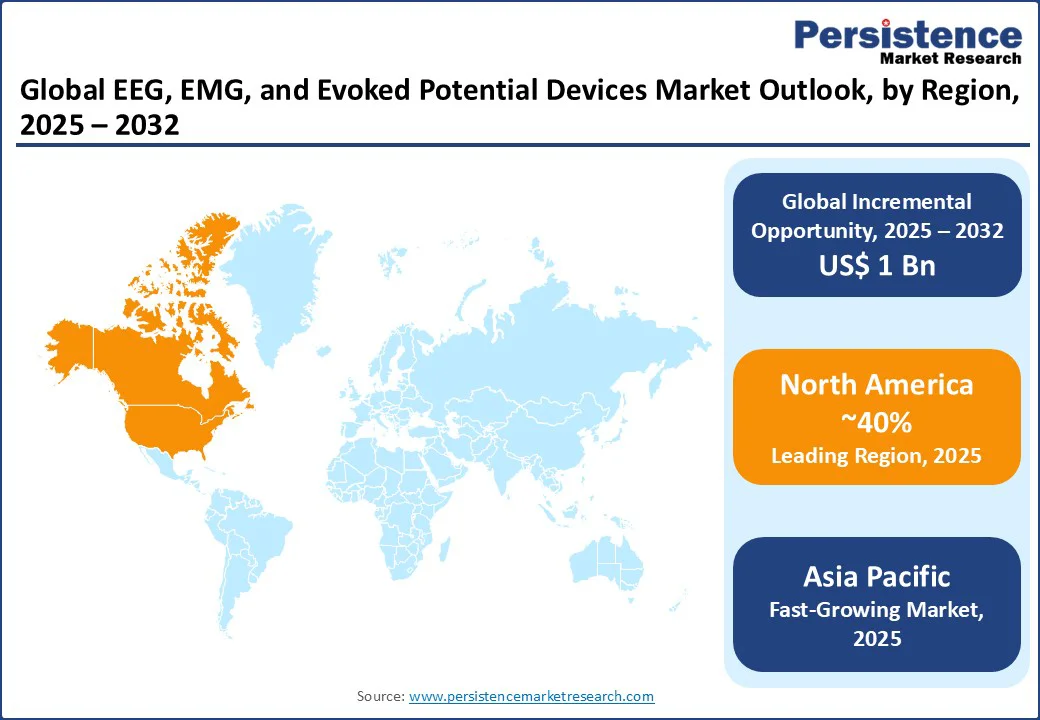ID: PMRREP3885| 176 Pages | 1 Sep 2025 | Format: PDF, Excel, PPT* | Healthcare

The global EEG, EMG, and evoked potential devices market size is likely to value at US$ 1.6 Bn in 2025 and reach US$ 2.6 Bn by 2032, registering a robust CAGR of 7.2% during the forecast period from 2025 to 2032.
The EEG, EMG, and evoked potential devices market has experienced steady growth, driven by the increasing prevalence of neurological and neuromuscular disorders, advancements in diagnostic technologies, and growing demand for non-invasive monitoring solutions. The sector is further propelled by the rising adoption of these devices in clinical settings, research applications, and rehabilitation programs, supported by innovations in wearable and biosensor technologies. The industry plays a critical role in enhancing diagnostic accuracy, patient monitoring, and therapeutic outcomes, making it a cornerstone of the medical device sector across various applications.
Key Industry Highlights:

|
Global Market Attribute |
Key Insights |
|
Market Size (2025E) |
US$ 1.6 Bn |
|
Market Value Forecast (2032F) |
US$ 2.6 Bn |
|
Projected Growth (CAGR 2025 to 2032) |
7.2% |
|
Historical Market Growth (CAGR 2019 to 2024) |
6.4% |
The increasing incidence of neurological conditions such as epilepsy, Parkinson’s disease, and multiple sclerosis, coupled with neuromuscular disorders such as muscular dystrophy, is a primary driver of market growth. According to the World Health Organization (WHO), neurological disorders affect over 1 billion people globally, with epilepsy alone impacting approximately 50 million individuals.
The growing burden of these conditions necessitates advanced diagnostic tools such as EEG, EMG, and evoked potential devices for accurate diagnosis and monitoring. For instance, EEG devices are critical for detecting abnormal brain activity in epilepsy patients, while EMG devices are essential for diagnosing conditions such as carpal tunnel syndrome and amyotrophic lateral sclerosis (ALS). The aging global population further exacerbates the prevalence of these disorders, particularly in developed regions such as North America and Europe, driving demand for reliable diagnostic solutions. Additionally, rising awareness of early diagnosis and treatment, supported by government healthcare initiatives, is accelerating the adoption of these devices, particularly in emerging markets.
The high cost associated with the development, acquisition, and maintenance of advanced EEG, EMG, and evoked potential devices poses a significant restraint. These devices, particularly those incorporating cutting-edge technologies such as wearable biosensors and intracranial systems, require substantial investment in research, manufacturing, and calibration.
For instance, a high-end EEG system with 128 channels can cost upwards of US$ 50,000, while maintenance and software updates add to the financial burden. Smaller healthcare facilities, especially in developing regions, struggle to afford these systems, limiting market penetration.
The need for specialized training to operate these devices increases operational costs, further restricting adoption in resource-constrained settings. These financial barriers can delay market expansion and limit accessibility, particularly in low-income regions.
The development and adoption of wearable and biosensor technologies are creating substantial growth opportunities in the EEG, EMG, and evoked potential devices market. Wearable EEG and EMG systems, such as lightweight headsets and skin patches, are gaining popularity because of their portability, user-friendliness, and ability to provide continuous, real-time monitoring outside of traditional clinical environments.
These devices empower patients to track neurological and muscular activity at home or in daily life, reducing the need for frequent hospital visits. The trend is closely aligned with the growing demand for patient-centric healthcare solutions and remote monitoring, which accelerated significantly after the COVID-19 pandemic.
Biosensor technologies are being integrated with EEG and EMG systems to detect subtle physiological changes, improving diagnostic accuracy and enabling personalized treatment strategies. For instance, Seer Medical’s FDA-cleared Seer Home system allows long-term home-based EEG monitoring for epilepsy patients, combining wearable sensors with cloud-based analytics. Such innovations highlight the strong push for non-invasive, cost-effective solutions. As affordability improves, adoption is expected to surge, particularly in emerging markets.
EEG devices dominate and account for approximately 45% of the share in 2025. Their dominance stems from the critical role in diagnosing neurological conditions such as epilepsy, brain injuries, and sleep disorders. EEG devices are widely used in hospitals and clinics due to their non-invasive nature and ability to provide detailed brain activity data. Leading players such as Natus Medical and Nihon Kohden offer advanced EEG systems with high-channel counts and AI integration, driving their widespread adoption.
The combined EEG/EMG devices segment is the fastest-growing, driven by the increasing demand for integrated diagnostic solutions that can simultaneously assess brain and muscle activity. These devices are particularly valuable in diagnosing complex neuromuscular disorders and are gaining traction in research and rehabilitation applications. The ability to streamline diagnostics and reduce testing time is accelerating the adoption of combined systems, particularly in advanced healthcare settings.
Clinical diagnosis holds the largest market share, accounting for approximately 59% of revenue. This segment’s dominance is driven by the critical role of EEG, EMG, and evoked potential devices in diagnosing neurological and neuromuscular conditions. The growing prevalence of disorders such as epilepsy, Parkinson’s disease, and peripheral neuropathy, coupled with the need for early and accurate diagnosis, fuels demand for these devices in clinical settings. Hospitals and diagnostic centers rely heavily on these tools to support patient care and treatment planning.
The research and development segment is the fastest-growing, driven by increasing investments in neurological research and the development of new therapeutic approaches. Academic institutions and research organizations are adopting advanced EEG and EMG systems to study brain function, neuromuscular interactions, and disease progression. The integration of AI and machine learning in these devices is enhancing their utility in research, driving rapid adoption.
Non-invasive technology leads accounting for a 61% share in 2025. Its dominance is driven by the widespread use in clinical diagnostics and patient monitoring, offering safety, ease of use, and broad applicability. Non-invasive EEG and EMG devices are preferred for their ability to provide accurate data without surgical intervention, making them suitable for a wide range of patients.
The wearable technology segment is the fastest-growing, fueled by innovations in portable and user-friendly devices. Wearable EEG and EMG systems, such as headbands and patches, are transforming patient monitoring by enabling continuous data collection in home and ambulatory settings. The growing demand for remote healthcare solutions and the integration of biosensors are accelerating the adoption of wearable technology globally.

North America holds the largest share of the global EEG, EMG, and Evoked Potential Devices market, accounting for approximately 40% in 2025. The United States is the primary driver, supported by its advanced healthcare infrastructure, high prevalence of neurological disorders, and substantial R&D investments. According to the Centers for Disease Control and Prevention (CDC), over three million adults in the U.S. are diagnosed with epilepsy, driving demand for EEG devices. The region’s strong focus on technological innovation, coupled with the presence of key players such as Natus Medical and Cadwell Laboratories, supports market growth.
The rapid adoption of digital health platforms and telemedicine has transformed the landscape, with wearable EEG and EMG devices gaining traction for remote monitoring. Additionally, the growing demand for non-invasive and sustainable diagnostic solutions is shaping manufacturers strategies, as healthcare providers prioritize patient safety and environmental considerations. Brick-and-mortar healthcare facilities, such as hospitals and specialty clinics, remain strong, complemented by an integrated online-offline ecosystem for device distribution and support. North America’s combination of advanced technology, regulatory support, and healthcare spending cements its position as a dominant and trendsetting market.
Europe represents a mature and sophisticated market, driven by its aging population, high healthcare standards, and stringent regulatory frameworks. Leading countries, including Germany, France, and the United Kingdom, contribute significantly to market growth. The aging population in Europe, with over 20% of the population aged 65 and older, drives demand for EEG and EMG devices for diagnosing age-related neurological disorders such as Alzheimer’s and Parkinson’s.
The European Medical Device Regulation (MDR) ensures high safety and quality standards, encouraging manufacturers to innovate with non-invasive and wearable technologies. Companies such as EB Neuro S.P.A. and Compumedics are leading through advanced product offerings and strategic partnerships with healthcare providers. The region’s strong emphasis on research and development, particularly in Germany and the UK, supports the adoption of these devices in academic and clinical settings. E-commerce platforms and digital health solutions are also gaining traction, enhancing accessibility across markets. Europe’s focus on sustainability and patient-centric care positions it as a key hub for innovation in the EEG, EMG, and Evoked Potential Devices market.
Asia Pacific is the fastest-growing region. The growth is primarily driven by rising healthcare expenditure, increasing prevalence of neurological disorders, and rapid adoption of advanced diagnostic technologies. Key countries, including China, India, and Japan, are leading the domain. China’s expanding healthcare infrastructure and government initiatives to improve diagnostic capabilities are driving demand for EEG and EMG devices. India’s growing middle-class population and increasing awareness of neurological conditions are fueling market growth, with local players offering affordable solutions. Japan’s focus on technological innovation, particularly in wearable and biosensor technologies, is transforming the industry.
The influence of digital health platforms, such as telemedicine and mobile health apps, is significant, with younger consumers driving demand for innovative devices. International brands such as Nihon Kohden are tailoring products to meet diverse regional needs, while local manufacturers are gaining prominence through cost-effective offerings. Asia Pacific’s blend of scale, innovation, and increasing healthcare access makes it the most dynamic hub for EEG, EMG, and Evoked Potential Devices.

The global EEG, EMG, and Evoked Potential Devices market is characterized by intense competition, regional strengths, and a mix of international and local manufacturers. In developed regions such as North America and Europe, large firms such as Natus Medical, Nihon Kohden, and Cadwell Laboratories dominate through scale, advanced R&D capabilities, and established partnerships with healthcare providers.
In Asia Pacific, rapid growth in healthcare infrastructure and increasing demand for affordable devices are attracting investments from both international players, such as Compumedics, and regional manufacturers. Companies are focusing on product innovation, affordability, and strategic alliances with hospitals and research institutions to gain a competitive edge. The development of wearable, non-invasive, and AI-integrated devices has emerged as a key differentiator, enabling faster market adoption and stronger brand loyalty.
Strategic collaborations, acquisitions, and digital-first approaches are further intensifying the competitive landscape. The sector exhibits a dual nature, consolidated at the top by global giants, while remaining fragmented across numerous regional and niche players addressing local needs.
Key Developments:
The global EEG, EMG, and Evoked Potential Devices market is projected to reach US$ 1.6 Bn in 2025.
The rising prevalence of neurological and neuromuscular disorders and advancements in diagnostic technologies are key drivers.
The EEG, EMG, and Evoked Potential Devices market is poised to witness a CAGR of 7.2% from 2025 to 2032.
Advancements in wearable and biosensor technologies present significant opportunities for market growth.
Cadwell Laboratories, Compumedics, Natus Medical, Nihon Kohden, and NeuroWave Systems are key players.
|
Report Attribute |
Details |
|
Historical Data/Actuals |
2019 - 2024 |
|
Forecast Period |
2025 - 2032 |
|
Market Analysis |
Value: US$ Bn, Volume: As Applicable |
|
Geographical Coverage |
|
|
Segmental Coverage |
|
|
Competitive Analysis |
|
|
Report Highlights |
|
|
Customization and Pricing |
|
By Device Type
By Application
By Technology
By Region
Delivery Timelines
For more information on this report and its delivery timelines please get in touch with our sales team.
About Author